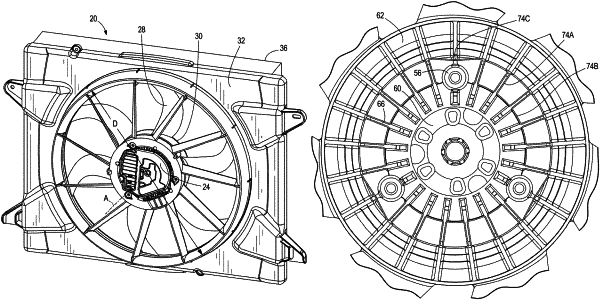| CPC F04D 29/668 (2013.01) [F04D 19/002 (2013.01); F04D 25/06 (2013.01); F04D 29/329 (2013.01)] | 20 Claims |

|
1. An axial fan assembly comprising:
a plurality of blades rotatable about a central axis;
a hub formed by a face portion that extends radially outwardly from the central axis and a cylindrical portion connecting the plurality of blades at radially-inner ends thereof;
a motor situated at least partially within a concavity of the hub and connected to an inner portion of the hub within the face portion, wherein the inner portion is isolated from an outer portion of the hub including the cylindrical portion by a plurality of slots; and
a plurality of ribs extending from the face portion axially toward the motor, each of the plurality of ribs having an unsupported region, the profile of which is defined by respective paths traversed by bordering ones of the plurality of slots,
wherein inner and outer attachment portions of the plurality of ribs extend radially inward and radially outward, respectively, from the unsupported region of each of the plurality of ribs to attach with the inner and outer hub portions,
wherein, when viewed along the central axis, a first thickness defined at the unsupported region of each of the plurality of ribs is less than a second thickness defined at one of the inner and outer attachment portions such that a ratio of the second thickness to the first thickness is 1.5:1 to 2.5:1,
wherein, along each of the plurality of ribs, curved transitions with transition radii are defined by mutual divergence of the respective paths traversed by the bordering ones of the plurality of slots at the transition from the first thickness to the second thickness, the transition radii extending uniformly along a full axial extent of each of the plurality of ribs.
|